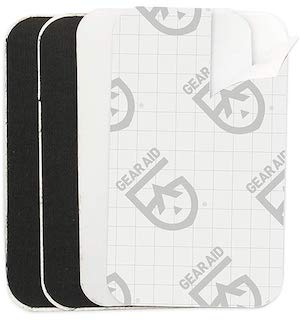Compression pants or clothing in general, are made to fit tightly to the skin in order to provide support and increase oxygen received. This results in better blood flow and functioning of the muscles, which is what makes them such a popular choice for amateur sports enthusiasts and athletes alike.
As you’ll likely know if you own compression pants, any kind of hole or tear in them can result in a fair amount of distress. This is because compression gear is notoriously difficult to patch up, due to the elastic material it is made up of.
So are ripped compression pants fixable? Yes, there are various ways you can patch up your compression pants by hand, using a sewing needle, some fabric glue, or a patch kit, and you also have the option of taking it to a professional tailor for the necessary fixes.
How to Fix Compression Pants
In this guide, we’ll get into all of the different ways you can go about fixing your compression pants, so it’ll be up to you to decide whether you want to have a go at it yourself or seek the professional help of a tailor near you.
Option 1: Take Them to A Tailor
The easiest and most reliable way to get your compression pants fixed up, albeit the most expensive, is to take them to a tailor.
A tailor will likely have worked with compression wear before, due to their rising popularity in recent years, so you can rely on them to do a great job of patching them up.
It might be that you have to make an extra effort to find someone used to dealing with sporting or gymnastics gear, to ensure the best chance of a permanent fix. This way you can almost guarantee that you’ll get your compression pants back with a stretch stitch that will keep up with your physical activities.
They will likely use a needle and thread or sewing machine to re-assemble the compression pants, in what should be a relatively straightforward fix.
Of course, working with compression pants is more difficult than normal pants due to the elastic material, but this shouldn’t be a problem for a trained professional in the clothing industry.
That being said, it’s always worth checking in with the tailor first, to make sure that they can do what you need them to. Call around to tailors near you, and ask them what they can do for your compression pants to get a better idea.
This fix is ideal for anyone who lacks the necessary sewing prowess to attempt to do this alone, but also for anyone looking for the most convenient fix. Say you’re short on time and you need your compression pants for an upcoming race or workout, then you can drop them off at the tailor’s and expect them back relatively quickly.
Also, and this is worth noting, fixing compression wear is challenging, so you don’t want to accidentally damage your compression pants by trying to fix them yourself. As a result, taking them to a tailor might turn out to be your only feasible option.
Option 2: Sew Them Yourself
The next option is for those daring enough to attempt to fix up the compression pants themselves. If you are proficient in sewing and have all the necessary equipment and some experience fixing up clothes, then this method will save you a lot of money and probably be your best bet.
Let’s take a look at how to fix a hole in the pants, as this should be relatively straightforward.
All you’ll need for this fix is:
- A sewing needle,
- some thread that matches the color of your pants (ideally),
- and some scissors.
- As with any sewing project, you’re going to start by threading the needle and cutting off the excess thread with your scissors.
- Turn your pants inside out, then sew over the seam, going from one side to the other, feeding your needle through the loop before it closes.
- Continue this process all the way along the seam.
- Once you’ve finished, knot the thread off and check the compression pants to see if the hole is completely sewn up.
This fix will also work fine for small, and even larger tears.
You should try your best to keep the sewing as loose as possible, since this will give your compression pants the best chance of retaining their naturally flexible nature.
Likewise, you can attempt to do this fix with the right fabric glue if you’re not as handy with a thread and needle.
It’s worth bearing in mind though, this fix might be temporary due to the strenuous activity you’ll likely put the compression pants through if you practice sports or work out on a regular basis.
If there is a hole in the seam of your pants, then you’ll want to watch this video by J Stern Designs.
Option 3: Use a Special Patch Kit
The last option available to you, short of buying a new pair of compression pants, is to find a special patch kit which will work with this type of material. Luckily for you, we’ve done the research, and found some options which could help you fix up your pants in no time.
The best patch you can use to fix compression pants is a Gore-TEX patch made by Gear Aid, called Tenacious Tape. This tape works will almost any garment of clothing, so can be of great use not just for your compression pants, but for any clothes you have that need patching up.
While it may not be as flexible as the Lycra material, the patch will still keep up with most physical activity and endure a fair amount of stretching.
The patch is both waterproof and breathable, and incredibly easy to use. In theory, this fix should last you a long time, but the company stresses that these won’t create a permanent fix. However, they will save you a potential expensive trip to the tailor.
To apply the patch, you don’t even need to know how to sew, all you have to do is apply the adhesive side of the patch to the hole or tear in the pants.
You can use an iron or another heat source to further seal the patch in place, but you should always check the label before attempting to use heat with your clothes.
Another alternative is to get your hands on some spare Lycra and cut it down to the perfect-sized patch to fix the pants.
To do this, you’ll have to sew the patch on yourself, which requires a little more effort. Gather together some nylon thread (since its stretchy), your sewing machine (ideally with a zig-zag or serger stitch), and a ballpoint needle.
Laying the patch behind the affected area, you’ll want to sew the edges and overlap the fabric for the best chance of a long-term fix.
Either way you do it, the patch fix can be an effective solution for wear and tear in your compression pants, and won’t be anywhere near as difficult to pull off as sewing the hole or tear up would be.
How to Care for Compression Pants
Now that we’ve seen some of the ways you can fix up your compression pants if holes or tears have appeared, let’s see how you can look after them to prevent such wear and tear happening again in the future.
The best thing you can do to preserve the condition and elasticity of your compression pants is to make sure you wash them properly.
Since compression wear is designed to be worn for exercise and physical activity, they can start to develop unwanted odors after a while. As a result, you will inevitably want to wash them to keep them smelling fresh and stain-free.
To do so, follow these simple steps.
- First, use a mild detergent so as not to damage the fine fibers used in compression pants.
- Also, don’t use fabric softener when you wash them as it can lead to the growth of bacteria.
- As for the washing process itself, they should be fine to throw in the washing machine, but there are some things to bear in mind.
- Place the pants and other compression wear you want to wash in a mesh laundry bag to protect them during the cycle. Then, start a gentle cycle with relatively cold water.
- You could also hand wash your compression pants with cold water, but refrain from stretching it too much or wringing them out.
- Never put your compression pants in the dryer. The heat can damage the fibers, so it’s best to let them dry naturally.
- As for the frequency, you should wash your compression legging fairly regularly, especially if you sweat a lot while wearing them.
Finally, as an important note, try not to throw your used compression pants in your gym bag with other dirty clothes as this can promote the growth of bacteria, which is the last thing you want.
Up Next: How To Repair Torn Baseball Pants

